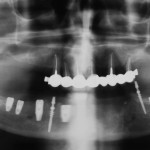
With increasing use of implants a greater variety of formats are becoming available. Early implants were typically 3.75-4mm in diameter and 7-20mm in length. Implants wider than 5mm have been use in some clinical situations, typically to avoid use of long implants in areas with limited bone height and outcomes for these wider implants are now being reported.
The aim of this review was to assess the survival rates of wide-diameter implants (platform diameter ≥5 mm) and assess clinical variables potentially affecting failure rates.
Methods
Searches were conducted in the Medline, Cochrane Central Register of Controlled Trials (CENTRAL) and Embase databases. This was supplemented by had searching a number of journals, Clinical Implant Dentistry & Related Research, Journal of Periodontology, Journal of Clinical Periodontology, International Journal of Periodontics and Restorative Dentistry, Clinical Oral Implants Research, International Journal of Oral & Maxillofacial Implants, Journal of Oral Implantology, Journal of Prosthetic Dentistry, International Journal of Prosthodontics, and Journal of Prosthodontics.
Randomised controlled trials (RCTs), retrospective or prospective cohort studies involving placement of wide-diameter implants (diameter ≥5 mm) and follow up of at least 1 year were considered. Study screening, data abstraction and quality assessment was carried out independently by two reviewers. The Cochrane risk of bias tool was used to assess RCTs and the Newcastle–Ottawa scale (NOS) for prospective or retrospective cohorts.
Implant failure rate was calculated. Failure rate per implant-year was analyzed using mix-effects Poisson regression model to obtain summary estimates of the 5-year survival rate. Relative risk (RR) was calculated to evaluate the association of different clinical variables with estimated failure rates.
Results
- 11 retrospective and 8 prospective studies involving a total of 1309 implants were included
- Follow up periods ranged from 12-60 months.
- Total number of implant failures was 80 (6.1%)
| Estimated failure rate per 100 implant-years | Average estimated 5-year survival rate | |
| Prospective studies |
0.45 (95%CI; 0.15-1.40) |
97.76% (95%CI; 93.25 -99.27) |
| Retrospective studies |
1.52 (95%CI; 0.51- 4.56) |
92.67% (95%CI; 79.60 -97.50) |
- Implant surface and implant diameter were significantly associated with the failure events in the retrospective studies.
Conclusions
The authors concluded:
Wide implant placement is a predictable procedure that has over 92% survival rate up to 5-year follow-up. Surface type and diameter of wide implants significantly affects the failure rate in the retrospective studies. Further prospective clinical trials with control groups should be conducted to directly compare the clinical outcomes of wide implant and narrower implant to provide stronger evidence of the effect of implant diameter on the long-term survival rate.
Comments
Three major databases and a wide range of dental journals have been hand searched for this review. However, only English language studies were included which means some relevant studies could have been excluded. Both retrospective and prospective studies have been included and while there is greater potential for retrospective studies to suffer from bias the two main groups of studies have been analysed separately. As noted by the authors a majority of the studies did not have a control group for comparison and only 3 of the included studies were of 5-years duration. Consequently high quality controlled studies are needed to better assess the outcomes of wider implants.
Links
Primary paper
Lee CT, Chen YW, Starr JR, Chuang SK. Survival analysis of wide dental implant: systematic review and meta-analysis. Clin Oral Implants Res. 2015 Dec 25. doi: 10.1111/clr.12730. [Epub ahead of print] Review. PubMed PMID: 26705937.
Other references
Dental Elf 18th Dec 2014 – Dental implants: review suggests high survival rates at over 10 years

Do wide dental implants have good 5-year survival rates?https://t.co/EBvnlbjuTF
Wide dental implants have good 5-year survival rates suggests review https://t.co/EBvnlbjuTF
5-year survival rates for wide dental implants- 92% suggests review https://t.co/EBvnlbjuTF
92% survival rate for wide dental implants at 5yrs suggests review https://t.co/EBvnlbjuTF
Review suggests 92% survival rate at 5 years for wide dental implants https://t.co/EBvnlbjuTF
Don’t miss – Wide dental implants have good 5-year survival rates suggests review https://t.co/EBvnlbjuTF
@davidbridges We only have evidence at 5yrs however, https://t.co/rOdF8HyPHc and this is limited!